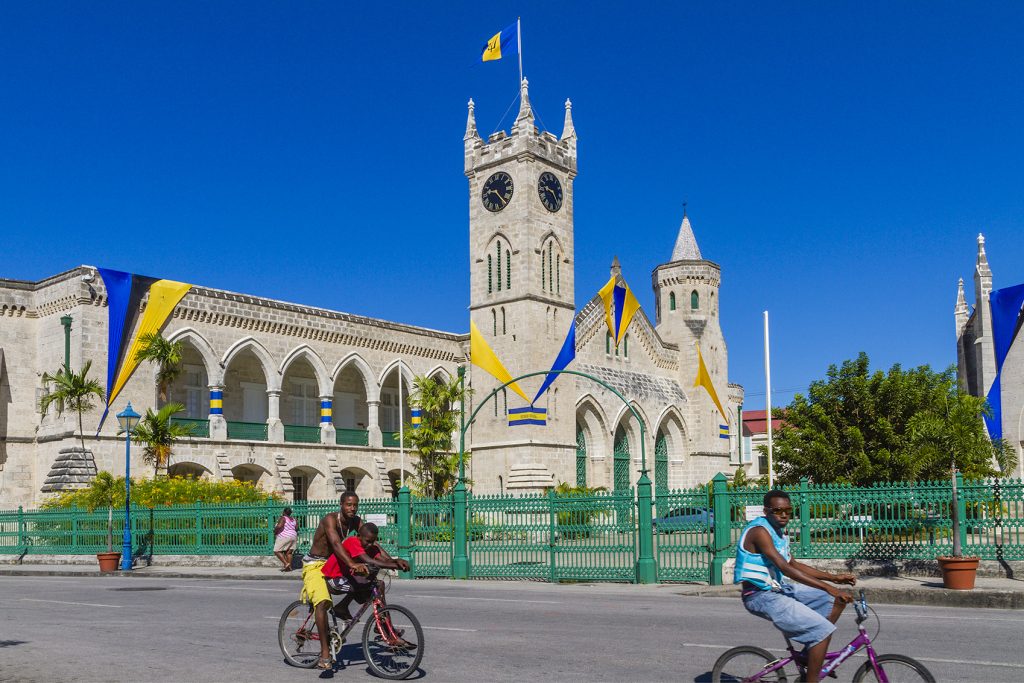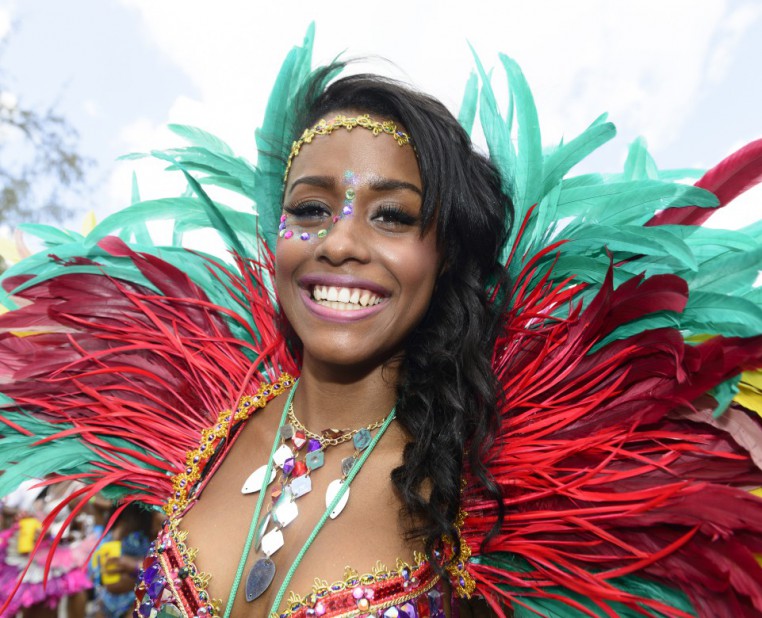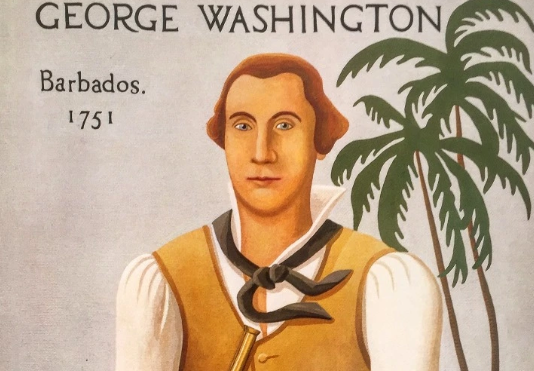| KEY FACTS | |
|---|---|
| Size | 169 square miles (439 square kilometers) |
| Population | 300,000 (90.4% African, 4.1% multiracial, 3.7% European, 1.7% other) |
| Status | Independent country, part of the British Commonwealth |
| Official language(s) | English |
| GDP per capita (2014) | $16,669 |
| Currency | Eastern Caribbean dollar pegged to US dollar |
| Electricity | US standard two-prong |
| Driving | on the left |
Independent from Great Britain since 1966, Barbados is a unique part of the Caribbean in many ways. It is the most eastward placed island of the Caribbean and theoretically not in the Caribbean sea, but fully in the Atlantic ocean. As such, the island is lucky to lay just outside paths of most hurricanes that form in the Atlantic. Hence, Barbados has been spared any major devastation from storms that occurred in the last couple years. Another feature that makes the island stand out is that its landmass is made up of coral and limestones, whereas most other Caribbean islands came about as a result of volcanic activity. This means the island’s land is fertile and, therefore, it has long been an important producer of sugarcane and agricultural products. With that in mind, Barbados has a long history of slavery, which can be explored throughout the island.
Finally, what makes Barbados unique among its neighbors is that its colonial history only involved Great Britain, which ruled the country between 1627 until it became independent in 1966 without any interruption from a conflict with another colonial power. As a result, Barbados is one of the most British places outside of Great Britain and surely the most British in the Caribbean!

Getting there
There are several airlines that fly non-stop to Barbados from the east coast of the United States including Delta (from Atlanta), JetBlue (from Boston, New York JFK and Fort Lauderdale) and American Airlines (from Miami). You can also fly direct from Toronto as well as London Heathrow (most flights from other parts of Europe will connect through London). Keep in mind that the Barbados’s Brantley Adams International Airport is a jump off point for other destinations in the Caribbean such as Martinique as well as St. Vincent and Grenadines. These flights take 30-45 minutes are there are usually at least several going back and forth every day. Therefore, you may want to combine your visit to Barbados with a visit to one of the other islands.
Getting around
With a reliable and inexpensive bus service from, into and around the capital of Bridgetown, Barbados offers great way to get around for money conscious travelers. Bus fare is fixed at Bds $2 and you need to use the local currency. Importantly, local public buses can be recognized by their color – blue with a yellow stripe whereas private (usually more expensive) are yellow with a blue stripe. Just like buses, Taxis in Barbados also use fixed rates so there should be no surprises as to what your ride costs. Note, however, that regular local taxis can only transport up to three people at once so if you are traveling with a bigger family, you will need to order a larger car/van.
If you want to rent a car, there are plenty of options to do so throughout the island with the airport being your best bet, of course. An American driver’s license needs to be complimented with a temporary local driving permit, which can be acquired from a rental company for Bds$10. In Barbados driving is on the left side and children under 5 need to ride in a child seat. It’s worth knowing that Bridgetown is a proper city with lots of traffic during the day so navigating around during business hours can be a very frustrating experience (and finding parking is often difficult). Driving outside the capital is much easier and the roads are generally in good condition.
Things to explore
A huge diversity of things to do in Barbados is one of its great selling points. The island’s varied landscape adds strength to this case as travelling through the island you may often think you have not only changed countries, but whole continents! The south and south-west of the island, which includes Bridgetown and the airport is dominated by an urban landscape of a busy and wide spread city. The west and north-west coast is home to many of the island’s luxury hotels and private estates and is characterized by pristine cove beaches and exclusive golf courses. The north, north-east and much of the east is rugged with cliffs and grassy hills alike those in Great Britain. Finally, central Barbados features vast forested rolling hills, which are home to many small and picturesque villages and sugar plantations.
All this geographic breakdown is useful to present as many of the attractions and activities are widely spread over the island so if your time is limited, it’s worth planning out what parts of the island you want and can visit during your stay. For those keen to explore Bridgetown, which is after all on the UNESCO’s World Heritage List, you can start with the colorful parliament buildings, which were constructed in the Victorian times and face the National Heroes Square – the site of Nelson’s monument constructed in 1813 and a beautiful fountain celebrating the advent of running water in the second half of 19th century. Behind the parliament buildings you will also find a local curiosity: Caribbean Wax Museum. Here you can meet some of the Caribbean’s most well-known dead and alive celebrities. For more serious sightseeing check out the Nidhe Israel Synagogue and cemetery, which was built as far back as 1630s by Jewish settlers from Brazil. And, if you are a true nature-lover, you will enjoy visiting Queen’s Park, just outside of Bridgetown, which features two huge baobab trees brought to Barbados from Guinea over 250 years ago.

Although Bridgetown does offer lots of attractions, the list of things to do outside the capital is very long. We will focus on just some of the key ones that are unique to the island and give you a true feel for it. For any history buff, do visit the Barbados Museum in Garrison, which showcases the island’s history all the way to 400 BC. Close by is the George Washington House, a Victorian era building where George Washington stayed in his youth. Also, don’t miss the Bussa Statue, which shows the leader of a slave rebellion of 1816. Lastly, on the other side of the island you will definitely want to visit St. Nicholas Abbey, a beautiful Jacobean house from 1650, which gives a glimpse of how people lived in that era. Once you are done with all the historical stuff, how about exploring some stunning nature and taking a couple amazing hikes? First, check out the Andromeda Botanic Gardens on the east coast, beautifully designed and well maintained lawns with hundreds of plants, flowers and trees from all over the world. Not far away is Flower Forest, a jungle like park with lovely hills and stunning views out to the eastern coast. About 15 minute drive from the forest you will find Harrison’s Cave – an impressive limestone cavern with an underground waterfall. Finally, if you have kids, they will love visiting the Barbados Wildlife Reserve, which you can combine with a visit to Farley Hill National Park. In the first location you will get a chance to interact with local fauna – turtles, monkeys, many types of amphibians and more whereas in the second location you will find some of the most impressive trees and gardens in all of Caribbean. Finally, you may know Barbados is a well known for its rum. In fact, it is the birthplace of this alcohol with first batches made back in 1703. To learn about its history and production, head to Mount Gay Centre where you can take a tour of the distillery, try different samples and buy the end product duty free. For even more rum fun, visit West Indies Distiller in Black Rock where you can combine rum tasting with a day on the beach.
Speaking of which, Barbados beaches are plentiful and can be generally grouped into the ones on the west and south coasts many of which, are cove like with generally calm, turquoise waters and crystal sands and beaches on the north and east side of the island, which have unsettled waters and are rugged, small and surrounded by tall cliffs. Although the southern and western beaches sound more appealing, the many cliffs on the northern and eastern sides are punctured by often beautiful caves and rock formations, which are very picturesque and offer something for a true adventurer. One good example is Animal Flower Cave on the North Point, where you can swim in solitude inside natural pools and snorkel around gorgeous corals. For even more solitude and privacy, our two beach recommendations for places not mentioned by many tour guides are: nested between rocks and easily accessible Batts Rock Beach as well as had to get to, but a lovely stretch of empty beach inside Hangman’s Bay (near Arawak Cement Company). Of course if you want to go mainstream, the south coast beaches like Dover, Miami or Pebbles Beach is where you want to be. These tend to be busy and noisy, but you can rent umbrellas and chairs, use bathrooms and choose from lots of food and drink options.
Accommodations
Barbados’ hotels are plentiful and cater to all kinds of needs. If you want to be in the midst of tourist activity, you will want to check out hotels in the area south of Bridgetown and along the coast spanning the whole parish of Christ Church. If you are willing to pay a little more and care for access to beautiful and private beach we recommend checking out Sugar Bay Barbados, which is amazingly located in a walking distance to large number of attractions yet, it feels to be far away from any civilization with its own private beach and beautiful gardens. Yet, in this area you will find as many as 50 other hotels for all budgets and preferences (with ranges from $50 to $800 per night). For slightly less busy surroundings, but equally great and plentiful hotels, head up north of Bridgetown, where you will find one of the most expensive hotels in all the Caribbean – Fairmont Royal Pavilion. A night here will set you back a cool $3,000, but for that you will get a beachfront setting, personalized service and plenty of privacy.
Now, if you are really keen on getting more of a local feel and don’t mind being slightly away from the beach, we recommend Colleton Guest House or a similar private guest house, which is run by a local family and feels more like a home than a hotel. Architecture, meals and surroundings of such guest houses make for a truly unique experience and a chance to explore local culture and lifestyle.
Food & restaurants
Few hotels in Barbados offer an all-inclusive option, which means local restaurants get plenty of hungry customers day and night. And indeed, many Barbados’ restaurants are first class and renown in all of the Caribbean. At the same time, many restaurants on the island can be quite fussy with their own opening hours and reservations. Whenever you plan a nice dinner that involves a longer commute, you will be best advised to call a restaurant ahead of time to make sure they will be open when you plan a visit and to book a table.
Seafood can be found in majority of menus. In fact, flying fish is the national dish, which you will find hard to miss and should definitely tried fried. Other local seafood specialties include Buljol (marinated cod) and stewed lambi (conch), which you will struggle to find in any restaurant outside of Barbados. What is also unique to the island is its annual Food, Wine and Rum Festival that happens every November and attracts some of the best chefs in the world. Visitors to this event not only get to try some amazing foods they also have a chance to drink the best rums as carefully selected by experts and connoisseurs.

Nightlife
There is no party like a Barbados party! Nightlife starts early and finishes late – in practice 4am is when you can expect most places to be be shutting down. The locals are out pretty much every night meeting at local rum bars (which count in the hundreds throughout the island) chatting, eating, dancing and, of course, drinking plenty of rum based drinks. Bar hopping is hence, a popular and an encouraged activity. One thing to note though is that although there is plenty of drinking going on and its legal from the age of 18, smoking, on the contrary, is prohibited pretty much in all indoor spaces and often in restaurants and bars with an outdoor space as well.
If you dance, you cannot miss visiting Harbour Lights in Bridgetown, a fantastic beachfront club with local bands and DJs. It is busy and fun every night of the week and is close by to another local favourite – The Boatyard. This bar also plays live music and serves some very creative rum cocktails. If you venture outside the capital on a Friday evening you will find a huge street party in Oistins on its Main Road. This is a proper late night eating adventure with lots of barbecues burning around and whole families feasting, singing and dancing. This is also where you will find Sugar Ultra Lounge, a well-known local dance club featuring international DJs and classy cocktails.
[embedyt]https://www.youtube.com/watch?v=SqcV0MwLlRc[/embedyt]Sports & adventure
As a British colony Barbados is full of cricket grounds as well as soccer and rugby fields. It is also full of players of these sports. But, if you are not into any of these activities, you will find plenty of others throughout the island and in its waters:
- Water sports – Barbados west and south coasts are home to some stunning coral reefs perfect for snorkelling and diving (examples: Bell Buoy, Dottins Reef and Silver Bank). The waters also contain as many as 20 sunken ships to explore, some easily accessible by diving beginners. For surfers, the east and south coasts offer great waves and winds all year round. However, November to January is when you can meet most professional surfers who visit the island for competitions
- Fishing and sea trips – Bridgetown is great launch point for fishing and you can easily rent a shared or private charter from The Careenage. Full day charter will set you back upwards of $1,000. A special attraction loved by families are mini-submarine excursions, which let you explore the depths of sea without getting wet. Check out Atlantis submarines here. Alternatively, have a think about trying one of party cruises which offer themed trips with meals, drinks, music and snorkelling. Most of these launch from Bridgetown port
- Golf – It would be difficult to count all large and small golf courses throughout the island. Unfortunately, some of them are only open to locals or long term members. However, there are a couple you where walk-ins are welcomed. These include Barbados Golf Club with a cost of $105 to play 18 holes, Country Club at Sandy Lane with a cost of $240 for 18 holes and Royal Wesmoreland Golf Club where you will pay $250 for a long game.
Safety and security
Although Barbados is does not have a very sophisticated economy and is somewhere in the middle of the Caribbean ranks as far as GDP per capita, the island is a stable country with a globally recognized brand for its tourism. It is a safe place for visitors and crime is not higher on average than in the US or most European countries. Of course, one should always be vigilant when venturing about the island. And if you are walking around Bridgetown at night, it is always better to not doing so alone.
The huge impact of COVID-19 on the Caribbean way of life
People of the Caribbean are known for their resilience. After all, few other populations have…
Explore Hunte’s Gardens in Barbados
Often when you’re travelling, it’s the people that make or break a place. Those you’ll…
Sightseeing After Dark
While the Caribbean is known for crystal blue waters, white sandy beaches, and afternoon cocktails,…
Mr. Washington Goes to Barbados
By 1751, tensions between the Britain’s North American Colonies and the British Empire were already…




